HR Strategy at Carlsberg: A Case Study Analysis of Winning Behaviours
VerifiedAdded on 2023/03/31
|12
|2362
|464
Case Study
AI Summary
This case study examines Carlsberg Group's 'Winning Behaviours' strategy, designed to integrate global business strategies and foster a common culture across its subsidiaries. It explores the strategic HR priorities, the rationale behind implementing the 'Winning Behaviours' strategy, and its alignment with HR practices like diversity, equity, workforce planning, social responsibility, and work-life balance. The analysis includes challenges faced during implementation in Malaysia and a discussion of how the strategy could work in an Australian context, along with recommendations for managing its strategic implementation through employee engagement, leadership restructuring, regular training, and alignment with existing HR practices. The paper concludes that the 'Winning Behaviours' strategy can be beneficial for integrating global business strategies and promoting a common culture, provided effective leadership and HR practices are incorporated.
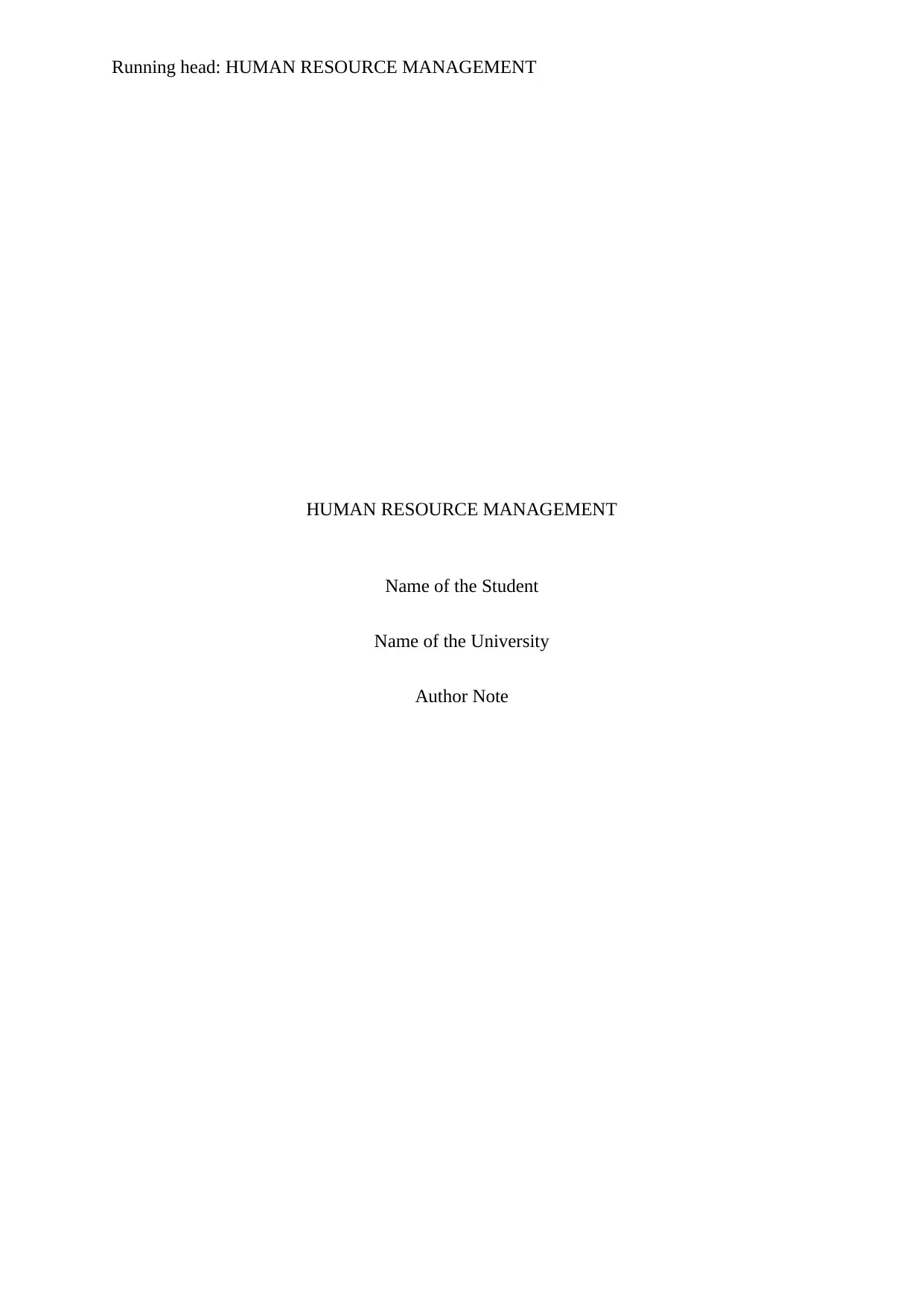
Running head: HUMAN RESOURCE MANAGEMENT
HUMAN RESOURCE MANAGEMENT
Name of the Student
Name of the University
Author Note
HUMAN RESOURCE MANAGEMENT
Name of the Student
Name of the University
Author Note
Paraphrase This Document
Need a fresh take? Get an instant paraphrase of this document with our AI Paraphraser
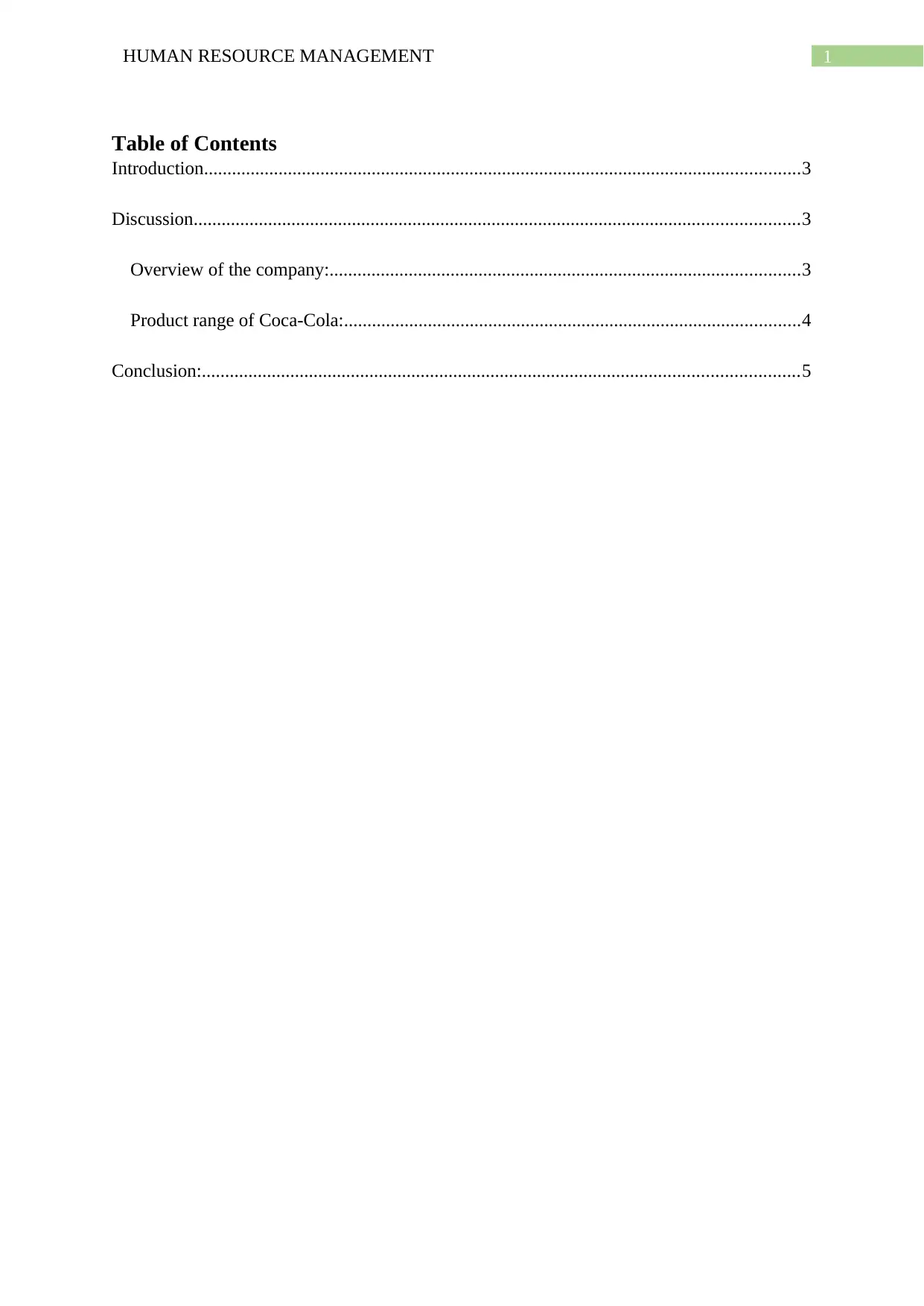
1HUMAN RESOURCE MANAGEMENT
Table of Contents
Introduction................................................................................................................................3
Discussion..................................................................................................................................3
Overview of the company:.....................................................................................................3
Product range of Coca-Cola:..................................................................................................4
Conclusion:................................................................................................................................5
Table of Contents
Introduction................................................................................................................................3
Discussion..................................................................................................................................3
Overview of the company:.....................................................................................................3
Product range of Coca-Cola:..................................................................................................4
Conclusion:................................................................................................................................5
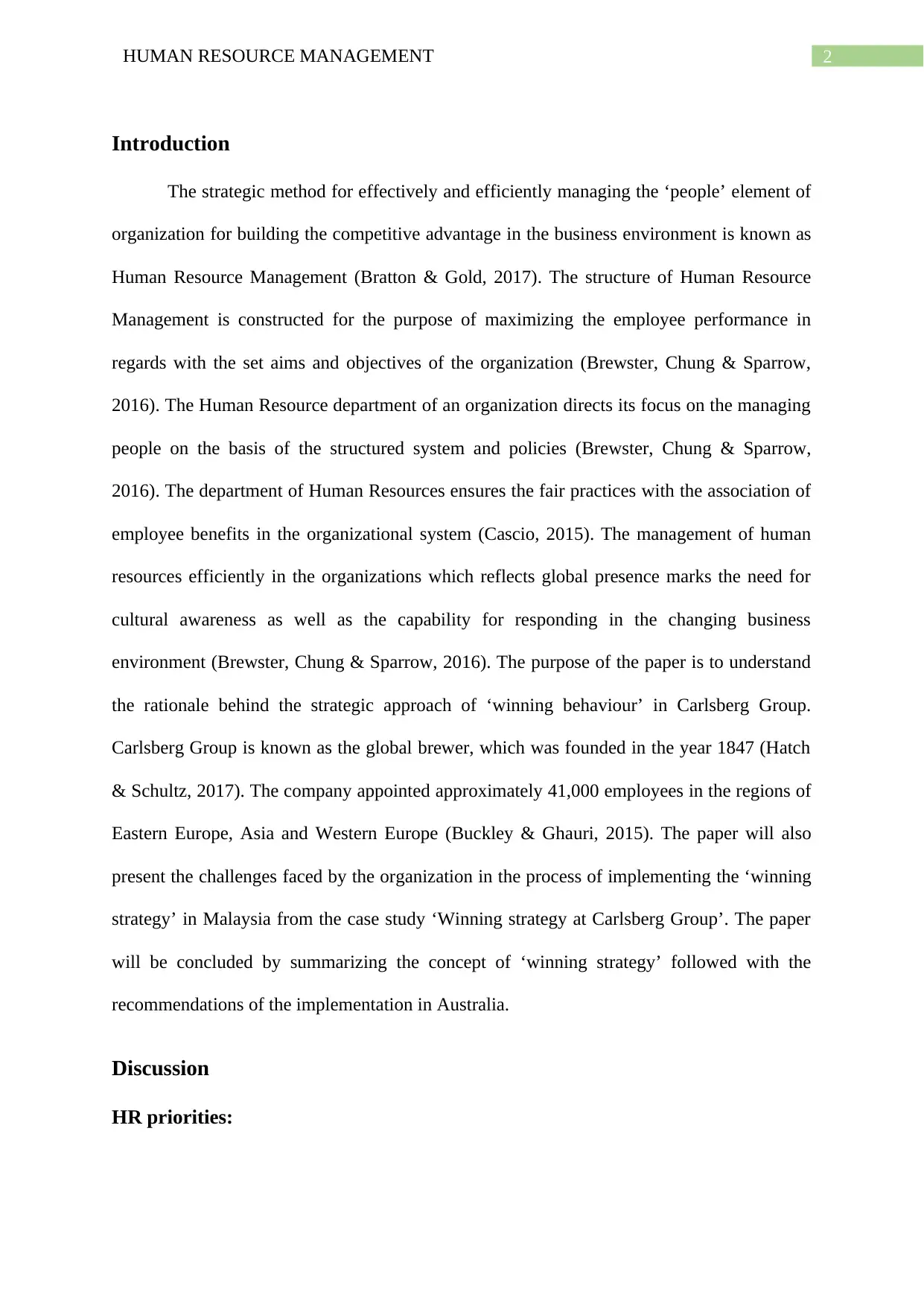
2HUMAN RESOURCE MANAGEMENT
Introduction
The strategic method for effectively and efficiently managing the ‘people’ element of
organization for building the competitive advantage in the business environment is known as
Human Resource Management (Bratton & Gold, 2017). The structure of Human Resource
Management is constructed for the purpose of maximizing the employee performance in
regards with the set aims and objectives of the organization (Brewster, Chung & Sparrow,
2016). The Human Resource department of an organization directs its focus on the managing
people on the basis of the structured system and policies (Brewster, Chung & Sparrow,
2016). The department of Human Resources ensures the fair practices with the association of
employee benefits in the organizational system (Cascio, 2015). The management of human
resources efficiently in the organizations which reflects global presence marks the need for
cultural awareness as well as the capability for responding in the changing business
environment (Brewster, Chung & Sparrow, 2016). The purpose of the paper is to understand
the rationale behind the strategic approach of ‘winning behaviour’ in Carlsberg Group.
Carlsberg Group is known as the global brewer, which was founded in the year 1847 (Hatch
& Schultz, 2017). The company appointed approximately 41,000 employees in the regions of
Eastern Europe, Asia and Western Europe (Buckley & Ghauri, 2015). The paper will also
present the challenges faced by the organization in the process of implementing the ‘winning
strategy’ in Malaysia from the case study ‘Winning strategy at Carlsberg Group’. The paper
will be concluded by summarizing the concept of ‘winning strategy’ followed with the
recommendations of the implementation in Australia.
Discussion
HR priorities:
Introduction
The strategic method for effectively and efficiently managing the ‘people’ element of
organization for building the competitive advantage in the business environment is known as
Human Resource Management (Bratton & Gold, 2017). The structure of Human Resource
Management is constructed for the purpose of maximizing the employee performance in
regards with the set aims and objectives of the organization (Brewster, Chung & Sparrow,
2016). The Human Resource department of an organization directs its focus on the managing
people on the basis of the structured system and policies (Brewster, Chung & Sparrow,
2016). The department of Human Resources ensures the fair practices with the association of
employee benefits in the organizational system (Cascio, 2015). The management of human
resources efficiently in the organizations which reflects global presence marks the need for
cultural awareness as well as the capability for responding in the changing business
environment (Brewster, Chung & Sparrow, 2016). The purpose of the paper is to understand
the rationale behind the strategic approach of ‘winning behaviour’ in Carlsberg Group.
Carlsberg Group is known as the global brewer, which was founded in the year 1847 (Hatch
& Schultz, 2017). The company appointed approximately 41,000 employees in the regions of
Eastern Europe, Asia and Western Europe (Buckley & Ghauri, 2015). The paper will also
present the challenges faced by the organization in the process of implementing the ‘winning
strategy’ in Malaysia from the case study ‘Winning strategy at Carlsberg Group’. The paper
will be concluded by summarizing the concept of ‘winning strategy’ followed with the
recommendations of the implementation in Australia.
Discussion
HR priorities:
⊘ This is a preview!⊘
Do you want full access?
Subscribe today to unlock all pages.

Trusted by 1+ million students worldwide
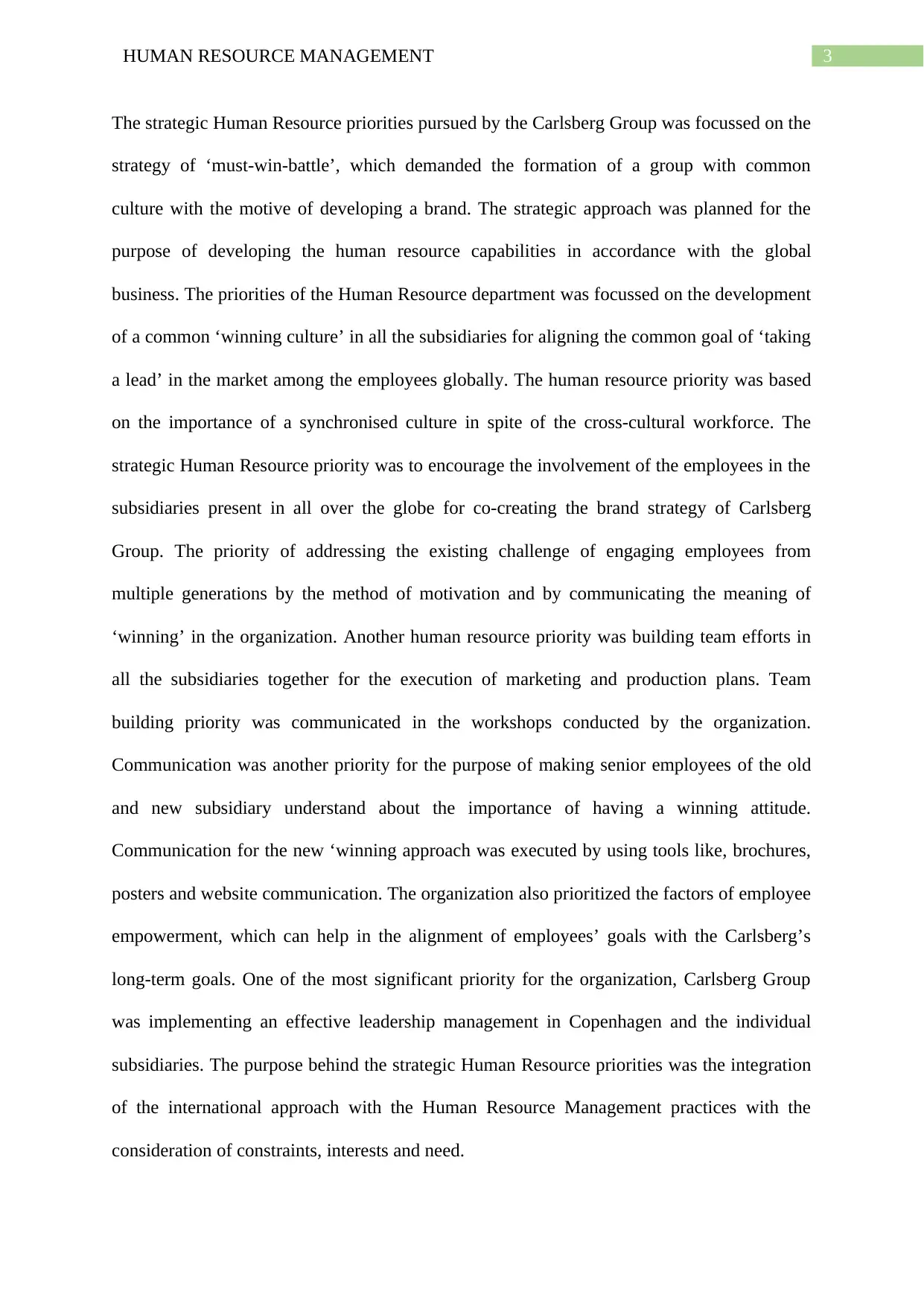
3HUMAN RESOURCE MANAGEMENT
The strategic Human Resource priorities pursued by the Carlsberg Group was focussed on the
strategy of ‘must-win-battle’, which demanded the formation of a group with common
culture with the motive of developing a brand. The strategic approach was planned for the
purpose of developing the human resource capabilities in accordance with the global
business. The priorities of the Human Resource department was focussed on the development
of a common ‘winning culture’ in all the subsidiaries for aligning the common goal of ‘taking
a lead’ in the market among the employees globally. The human resource priority was based
on the importance of a synchronised culture in spite of the cross-cultural workforce. The
strategic Human Resource priority was to encourage the involvement of the employees in the
subsidiaries present in all over the globe for co-creating the brand strategy of Carlsberg
Group. The priority of addressing the existing challenge of engaging employees from
multiple generations by the method of motivation and by communicating the meaning of
‘winning’ in the organization. Another human resource priority was building team efforts in
all the subsidiaries together for the execution of marketing and production plans. Team
building priority was communicated in the workshops conducted by the organization.
Communication was another priority for the purpose of making senior employees of the old
and new subsidiary understand about the importance of having a winning attitude.
Communication for the new ‘winning approach was executed by using tools like, brochures,
posters and website communication. The organization also prioritized the factors of employee
empowerment, which can help in the alignment of employees’ goals with the Carlsberg’s
long-term goals. One of the most significant priority for the organization, Carlsberg Group
was implementing an effective leadership management in Copenhagen and the individual
subsidiaries. The purpose behind the strategic Human Resource priorities was the integration
of the international approach with the Human Resource Management practices with the
consideration of constraints, interests and need.
The strategic Human Resource priorities pursued by the Carlsberg Group was focussed on the
strategy of ‘must-win-battle’, which demanded the formation of a group with common
culture with the motive of developing a brand. The strategic approach was planned for the
purpose of developing the human resource capabilities in accordance with the global
business. The priorities of the Human Resource department was focussed on the development
of a common ‘winning culture’ in all the subsidiaries for aligning the common goal of ‘taking
a lead’ in the market among the employees globally. The human resource priority was based
on the importance of a synchronised culture in spite of the cross-cultural workforce. The
strategic Human Resource priority was to encourage the involvement of the employees in the
subsidiaries present in all over the globe for co-creating the brand strategy of Carlsberg
Group. The priority of addressing the existing challenge of engaging employees from
multiple generations by the method of motivation and by communicating the meaning of
‘winning’ in the organization. Another human resource priority was building team efforts in
all the subsidiaries together for the execution of marketing and production plans. Team
building priority was communicated in the workshops conducted by the organization.
Communication was another priority for the purpose of making senior employees of the old
and new subsidiary understand about the importance of having a winning attitude.
Communication for the new ‘winning approach was executed by using tools like, brochures,
posters and website communication. The organization also prioritized the factors of employee
empowerment, which can help in the alignment of employees’ goals with the Carlsberg’s
long-term goals. One of the most significant priority for the organization, Carlsberg Group
was implementing an effective leadership management in Copenhagen and the individual
subsidiaries. The purpose behind the strategic Human Resource priorities was the integration
of the international approach with the Human Resource Management practices with the
consideration of constraints, interests and need.
Paraphrase This Document
Need a fresh take? Get an instant paraphrase of this document with our AI Paraphraser
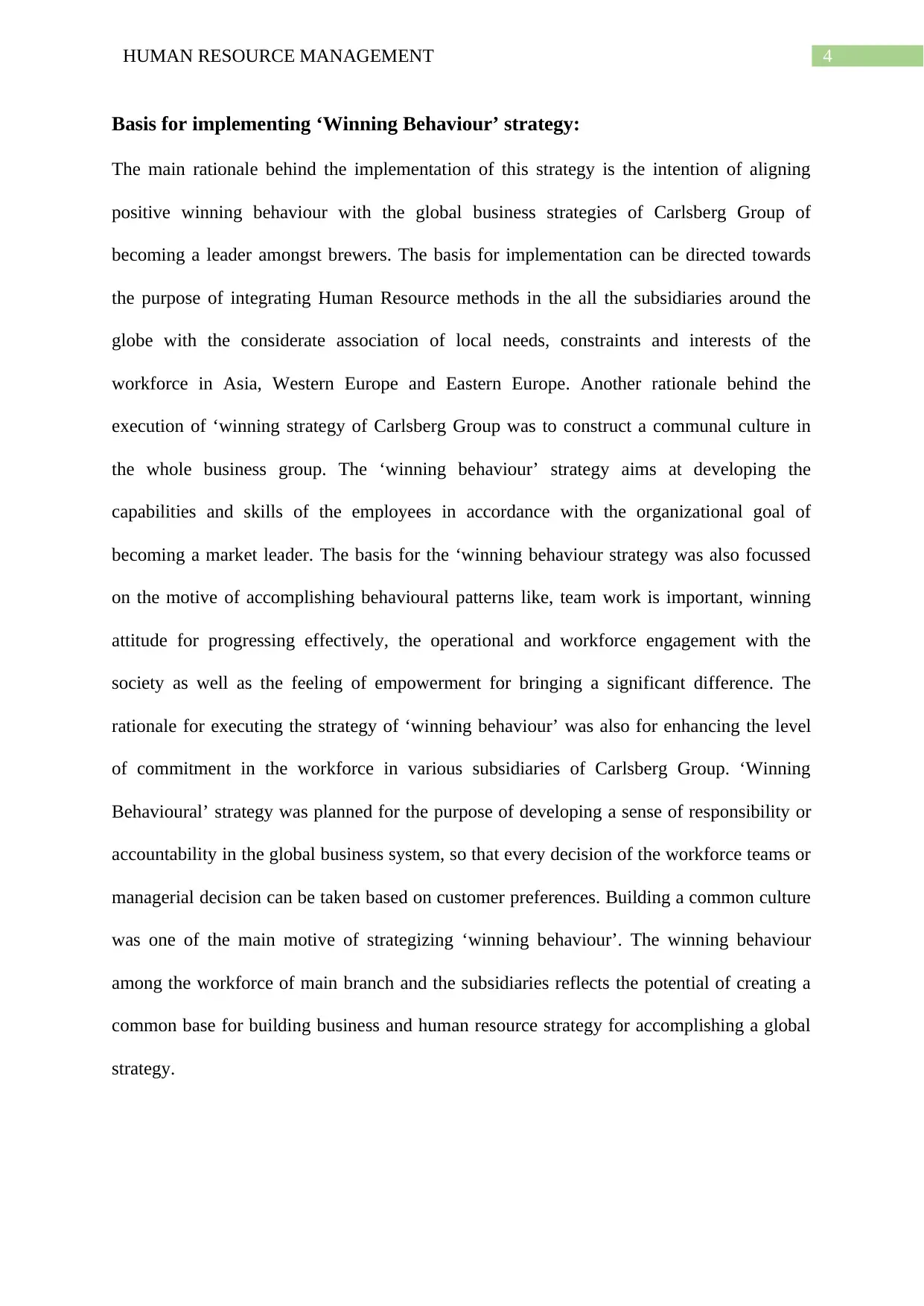
4HUMAN RESOURCE MANAGEMENT
Basis for implementing ‘Winning Behaviour’ strategy:
The main rationale behind the implementation of this strategy is the intention of aligning
positive winning behaviour with the global business strategies of Carlsberg Group of
becoming a leader amongst brewers. The basis for implementation can be directed towards
the purpose of integrating Human Resource methods in the all the subsidiaries around the
globe with the considerate association of local needs, constraints and interests of the
workforce in Asia, Western Europe and Eastern Europe. Another rationale behind the
execution of ‘winning strategy of Carlsberg Group was to construct a communal culture in
the whole business group. The ‘winning behaviour’ strategy aims at developing the
capabilities and skills of the employees in accordance with the organizational goal of
becoming a market leader. The basis for the ‘winning behaviour strategy was also focussed
on the motive of accomplishing behavioural patterns like, team work is important, winning
attitude for progressing effectively, the operational and workforce engagement with the
society as well as the feeling of empowerment for bringing a significant difference. The
rationale for executing the strategy of ‘winning behaviour’ was also for enhancing the level
of commitment in the workforce in various subsidiaries of Carlsberg Group. ‘Winning
Behavioural’ strategy was planned for the purpose of developing a sense of responsibility or
accountability in the global business system, so that every decision of the workforce teams or
managerial decision can be taken based on customer preferences. Building a common culture
was one of the main motive of strategizing ‘winning behaviour’. The winning behaviour
among the workforce of main branch and the subsidiaries reflects the potential of creating a
common base for building business and human resource strategy for accomplishing a global
strategy.
Basis for implementing ‘Winning Behaviour’ strategy:
The main rationale behind the implementation of this strategy is the intention of aligning
positive winning behaviour with the global business strategies of Carlsberg Group of
becoming a leader amongst brewers. The basis for implementation can be directed towards
the purpose of integrating Human Resource methods in the all the subsidiaries around the
globe with the considerate association of local needs, constraints and interests of the
workforce in Asia, Western Europe and Eastern Europe. Another rationale behind the
execution of ‘winning strategy of Carlsberg Group was to construct a communal culture in
the whole business group. The ‘winning behaviour’ strategy aims at developing the
capabilities and skills of the employees in accordance with the organizational goal of
becoming a market leader. The basis for the ‘winning behaviour strategy was also focussed
on the motive of accomplishing behavioural patterns like, team work is important, winning
attitude for progressing effectively, the operational and workforce engagement with the
society as well as the feeling of empowerment for bringing a significant difference. The
rationale for executing the strategy of ‘winning behaviour’ was also for enhancing the level
of commitment in the workforce in various subsidiaries of Carlsberg Group. ‘Winning
Behavioural’ strategy was planned for the purpose of developing a sense of responsibility or
accountability in the global business system, so that every decision of the workforce teams or
managerial decision can be taken based on customer preferences. Building a common culture
was one of the main motive of strategizing ‘winning behaviour’. The winning behaviour
among the workforce of main branch and the subsidiaries reflects the potential of creating a
common base for building business and human resource strategy for accomplishing a global
strategy.
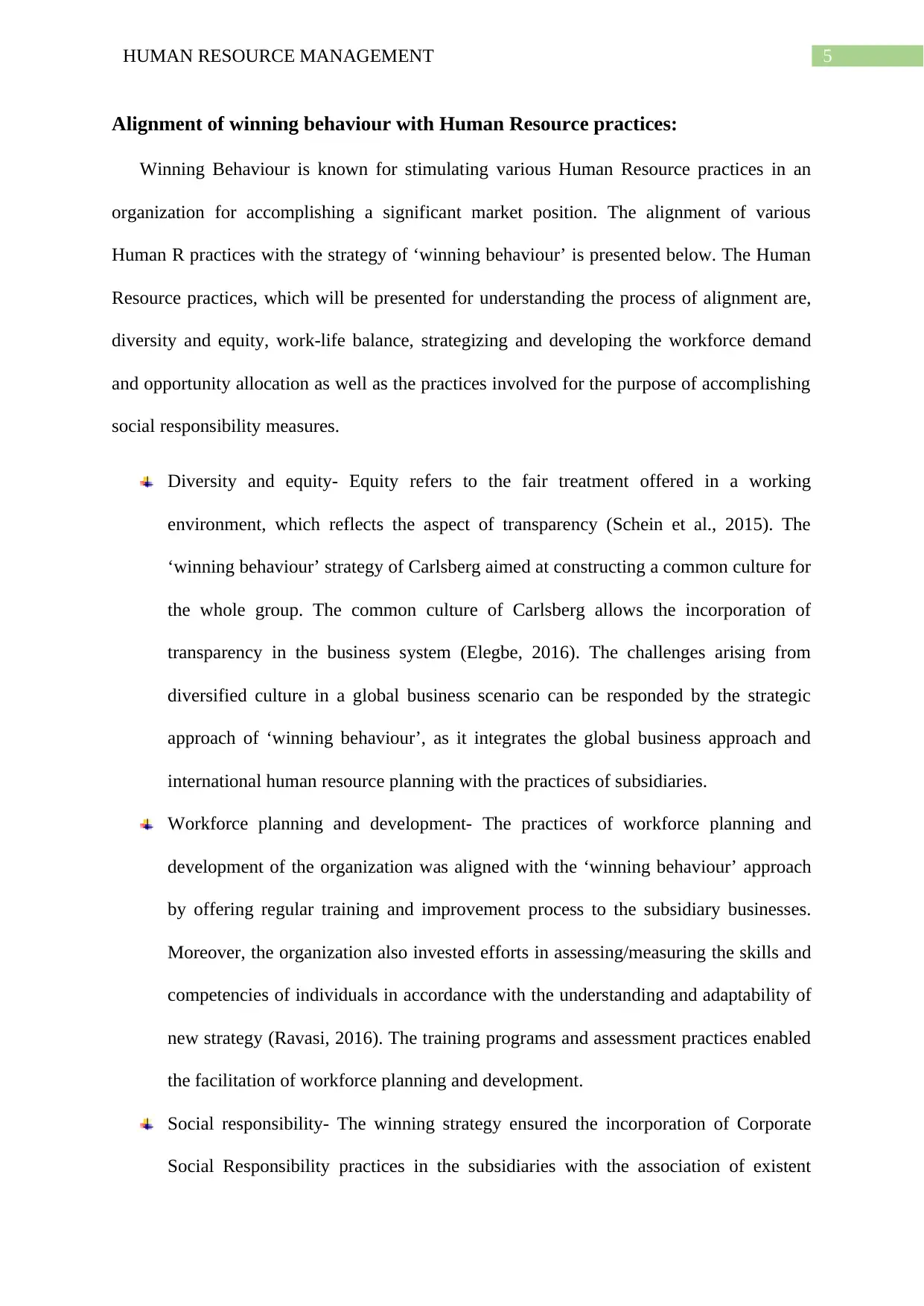
5HUMAN RESOURCE MANAGEMENT
Alignment of winning behaviour with Human Resource practices:
Winning Behaviour is known for stimulating various Human Resource practices in an
organization for accomplishing a significant market position. The alignment of various
Human R practices with the strategy of ‘winning behaviour’ is presented below. The Human
Resource practices, which will be presented for understanding the process of alignment are,
diversity and equity, work-life balance, strategizing and developing the workforce demand
and opportunity allocation as well as the practices involved for the purpose of accomplishing
social responsibility measures.
Diversity and equity- Equity refers to the fair treatment offered in a working
environment, which reflects the aspect of transparency (Schein et al., 2015). The
‘winning behaviour’ strategy of Carlsberg aimed at constructing a common culture for
the whole group. The common culture of Carlsberg allows the incorporation of
transparency in the business system (Elegbe, 2016). The challenges arising from
diversified culture in a global business scenario can be responded by the strategic
approach of ‘winning behaviour’, as it integrates the global business approach and
international human resource planning with the practices of subsidiaries.
Workforce planning and development- The practices of workforce planning and
development of the organization was aligned with the ‘winning behaviour’ approach
by offering regular training and improvement process to the subsidiary businesses.
Moreover, the organization also invested efforts in assessing/measuring the skills and
competencies of individuals in accordance with the understanding and adaptability of
new strategy (Ravasi, 2016). The training programs and assessment practices enabled
the facilitation of workforce planning and development.
Social responsibility- The winning strategy ensured the incorporation of Corporate
Social Responsibility practices in the subsidiaries with the association of existent
Alignment of winning behaviour with Human Resource practices:
Winning Behaviour is known for stimulating various Human Resource practices in an
organization for accomplishing a significant market position. The alignment of various
Human R practices with the strategy of ‘winning behaviour’ is presented below. The Human
Resource practices, which will be presented for understanding the process of alignment are,
diversity and equity, work-life balance, strategizing and developing the workforce demand
and opportunity allocation as well as the practices involved for the purpose of accomplishing
social responsibility measures.
Diversity and equity- Equity refers to the fair treatment offered in a working
environment, which reflects the aspect of transparency (Schein et al., 2015). The
‘winning behaviour’ strategy of Carlsberg aimed at constructing a common culture for
the whole group. The common culture of Carlsberg allows the incorporation of
transparency in the business system (Elegbe, 2016). The challenges arising from
diversified culture in a global business scenario can be responded by the strategic
approach of ‘winning behaviour’, as it integrates the global business approach and
international human resource planning with the practices of subsidiaries.
Workforce planning and development- The practices of workforce planning and
development of the organization was aligned with the ‘winning behaviour’ approach
by offering regular training and improvement process to the subsidiary businesses.
Moreover, the organization also invested efforts in assessing/measuring the skills and
competencies of individuals in accordance with the understanding and adaptability of
new strategy (Ravasi, 2016). The training programs and assessment practices enabled
the facilitation of workforce planning and development.
Social responsibility- The winning strategy ensured the incorporation of Corporate
Social Responsibility practices in the subsidiaries with the association of existent
⊘ This is a preview!⊘
Do you want full access?
Subscribe today to unlock all pages.

Trusted by 1+ million students worldwide
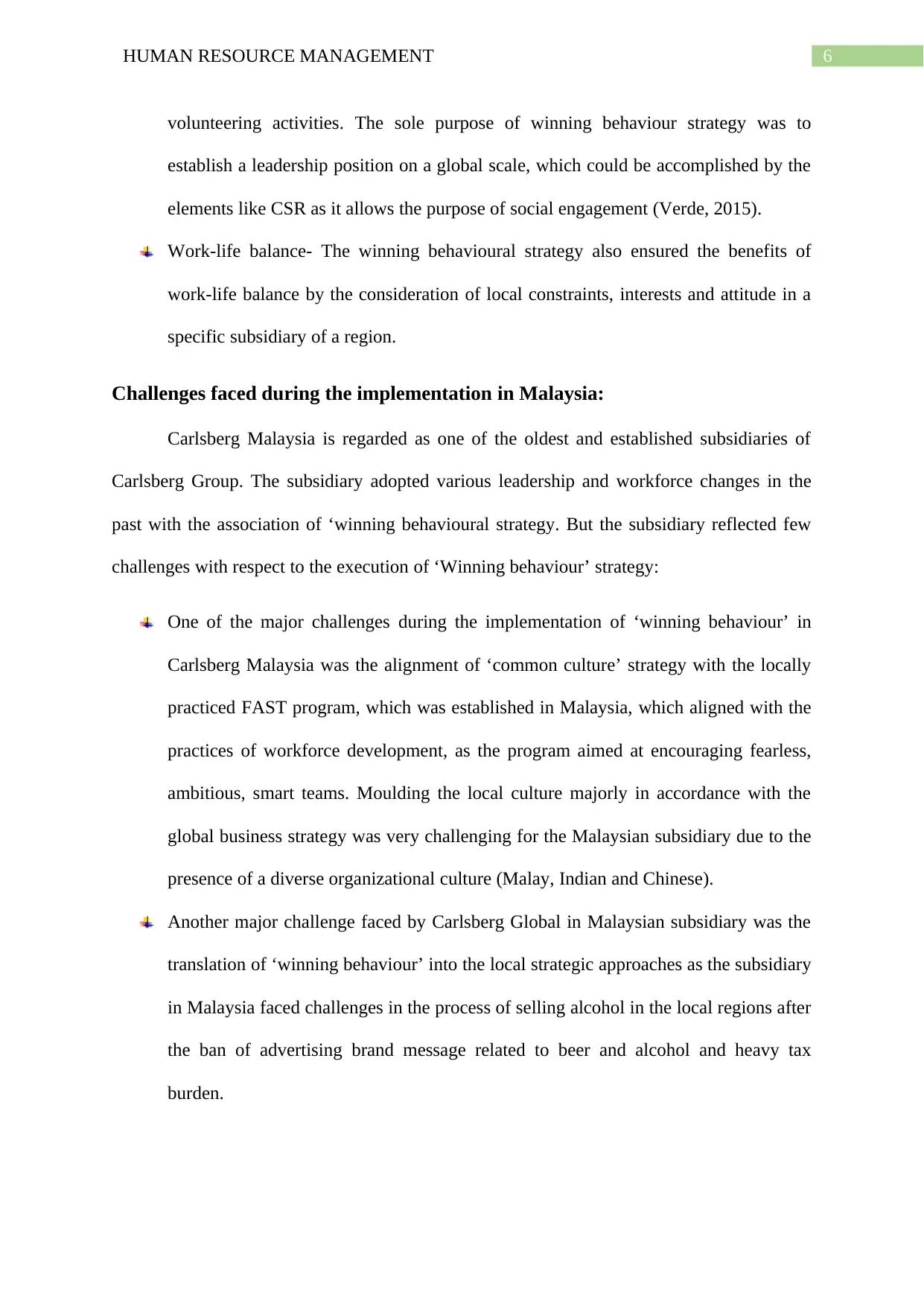
6HUMAN RESOURCE MANAGEMENT
volunteering activities. The sole purpose of winning behaviour strategy was to
establish a leadership position on a global scale, which could be accomplished by the
elements like CSR as it allows the purpose of social engagement (Verde, 2015).
Work-life balance- The winning behavioural strategy also ensured the benefits of
work-life balance by the consideration of local constraints, interests and attitude in a
specific subsidiary of a region.
Challenges faced during the implementation in Malaysia:
Carlsberg Malaysia is regarded as one of the oldest and established subsidiaries of
Carlsberg Group. The subsidiary adopted various leadership and workforce changes in the
past with the association of ‘winning behavioural strategy. But the subsidiary reflected few
challenges with respect to the execution of ‘Winning behaviour’ strategy:
One of the major challenges during the implementation of ‘winning behaviour’ in
Carlsberg Malaysia was the alignment of ‘common culture’ strategy with the locally
practiced FAST program, which was established in Malaysia, which aligned with the
practices of workforce development, as the program aimed at encouraging fearless,
ambitious, smart teams. Moulding the local culture majorly in accordance with the
global business strategy was very challenging for the Malaysian subsidiary due to the
presence of a diverse organizational culture (Malay, Indian and Chinese).
Another major challenge faced by Carlsberg Global in Malaysian subsidiary was the
translation of ‘winning behaviour’ into the local strategic approaches as the subsidiary
in Malaysia faced challenges in the process of selling alcohol in the local regions after
the ban of advertising brand message related to beer and alcohol and heavy tax
burden.
volunteering activities. The sole purpose of winning behaviour strategy was to
establish a leadership position on a global scale, which could be accomplished by the
elements like CSR as it allows the purpose of social engagement (Verde, 2015).
Work-life balance- The winning behavioural strategy also ensured the benefits of
work-life balance by the consideration of local constraints, interests and attitude in a
specific subsidiary of a region.
Challenges faced during the implementation in Malaysia:
Carlsberg Malaysia is regarded as one of the oldest and established subsidiaries of
Carlsberg Group. The subsidiary adopted various leadership and workforce changes in the
past with the association of ‘winning behavioural strategy. But the subsidiary reflected few
challenges with respect to the execution of ‘Winning behaviour’ strategy:
One of the major challenges during the implementation of ‘winning behaviour’ in
Carlsberg Malaysia was the alignment of ‘common culture’ strategy with the locally
practiced FAST program, which was established in Malaysia, which aligned with the
practices of workforce development, as the program aimed at encouraging fearless,
ambitious, smart teams. Moulding the local culture majorly in accordance with the
global business strategy was very challenging for the Malaysian subsidiary due to the
presence of a diverse organizational culture (Malay, Indian and Chinese).
Another major challenge faced by Carlsberg Global in Malaysian subsidiary was the
translation of ‘winning behaviour’ into the local strategic approaches as the subsidiary
in Malaysia faced challenges in the process of selling alcohol in the local regions after
the ban of advertising brand message related to beer and alcohol and heavy tax
burden.
Paraphrase This Document
Need a fresh take? Get an instant paraphrase of this document with our AI Paraphraser
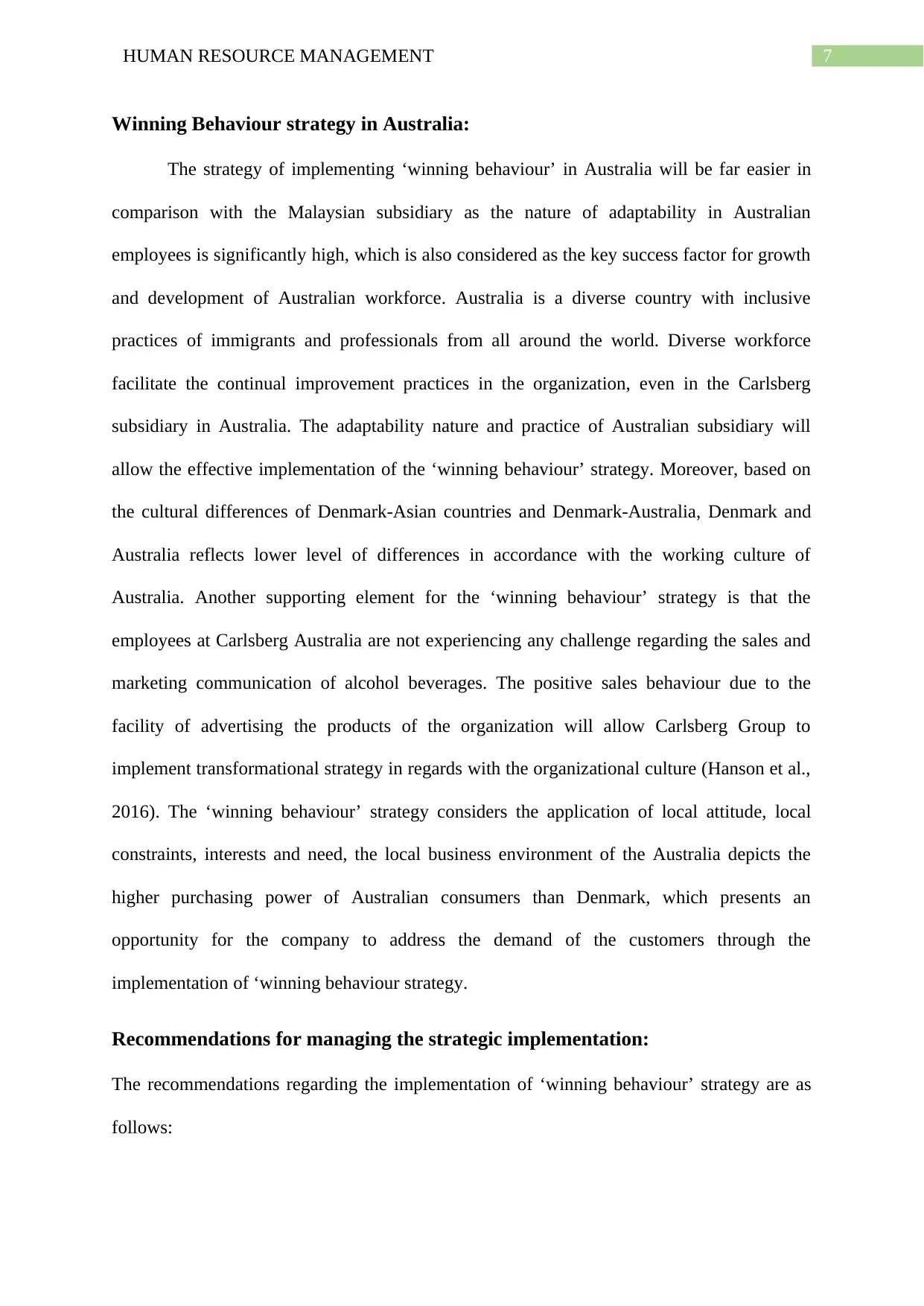
7HUMAN RESOURCE MANAGEMENT
Winning Behaviour strategy in Australia:
The strategy of implementing ‘winning behaviour’ in Australia will be far easier in
comparison with the Malaysian subsidiary as the nature of adaptability in Australian
employees is significantly high, which is also considered as the key success factor for growth
and development of Australian workforce. Australia is a diverse country with inclusive
practices of immigrants and professionals from all around the world. Diverse workforce
facilitate the continual improvement practices in the organization, even in the Carlsberg
subsidiary in Australia. The adaptability nature and practice of Australian subsidiary will
allow the effective implementation of the ‘winning behaviour’ strategy. Moreover, based on
the cultural differences of Denmark-Asian countries and Denmark-Australia, Denmark and
Australia reflects lower level of differences in accordance with the working culture of
Australia. Another supporting element for the ‘winning behaviour’ strategy is that the
employees at Carlsberg Australia are not experiencing any challenge regarding the sales and
marketing communication of alcohol beverages. The positive sales behaviour due to the
facility of advertising the products of the organization will allow Carlsberg Group to
implement transformational strategy in regards with the organizational culture (Hanson et al.,
2016). The ‘winning behaviour’ strategy considers the application of local attitude, local
constraints, interests and need, the local business environment of the Australia depicts the
higher purchasing power of Australian consumers than Denmark, which presents an
opportunity for the company to address the demand of the customers through the
implementation of ‘winning behaviour strategy.
Recommendations for managing the strategic implementation:
The recommendations regarding the implementation of ‘winning behaviour’ strategy are as
follows:
Winning Behaviour strategy in Australia:
The strategy of implementing ‘winning behaviour’ in Australia will be far easier in
comparison with the Malaysian subsidiary as the nature of adaptability in Australian
employees is significantly high, which is also considered as the key success factor for growth
and development of Australian workforce. Australia is a diverse country with inclusive
practices of immigrants and professionals from all around the world. Diverse workforce
facilitate the continual improvement practices in the organization, even in the Carlsberg
subsidiary in Australia. The adaptability nature and practice of Australian subsidiary will
allow the effective implementation of the ‘winning behaviour’ strategy. Moreover, based on
the cultural differences of Denmark-Asian countries and Denmark-Australia, Denmark and
Australia reflects lower level of differences in accordance with the working culture of
Australia. Another supporting element for the ‘winning behaviour’ strategy is that the
employees at Carlsberg Australia are not experiencing any challenge regarding the sales and
marketing communication of alcohol beverages. The positive sales behaviour due to the
facility of advertising the products of the organization will allow Carlsberg Group to
implement transformational strategy in regards with the organizational culture (Hanson et al.,
2016). The ‘winning behaviour’ strategy considers the application of local attitude, local
constraints, interests and need, the local business environment of the Australia depicts the
higher purchasing power of Australian consumers than Denmark, which presents an
opportunity for the company to address the demand of the customers through the
implementation of ‘winning behaviour strategy.
Recommendations for managing the strategic implementation:
The recommendations regarding the implementation of ‘winning behaviour’ strategy are as
follows:
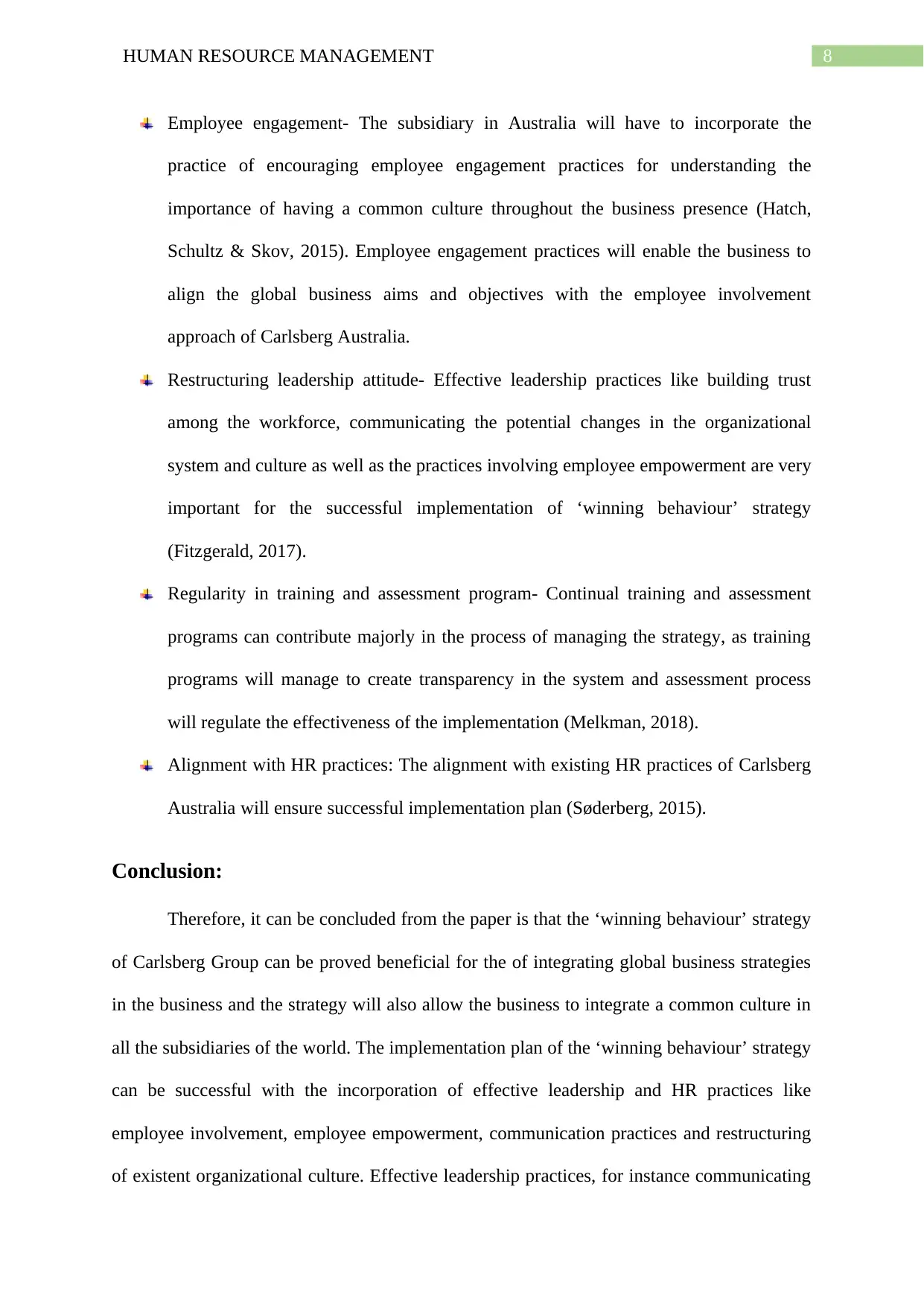
8HUMAN RESOURCE MANAGEMENT
Employee engagement- The subsidiary in Australia will have to incorporate the
practice of encouraging employee engagement practices for understanding the
importance of having a common culture throughout the business presence (Hatch,
Schultz & Skov, 2015). Employee engagement practices will enable the business to
align the global business aims and objectives with the employee involvement
approach of Carlsberg Australia.
Restructuring leadership attitude- Effective leadership practices like building trust
among the workforce, communicating the potential changes in the organizational
system and culture as well as the practices involving employee empowerment are very
important for the successful implementation of ‘winning behaviour’ strategy
(Fitzgerald, 2017).
Regularity in training and assessment program- Continual training and assessment
programs can contribute majorly in the process of managing the strategy, as training
programs will manage to create transparency in the system and assessment process
will regulate the effectiveness of the implementation (Melkman, 2018).
Alignment with HR practices: The alignment with existing HR practices of Carlsberg
Australia will ensure successful implementation plan (Søderberg, 2015).
Conclusion:
Therefore, it can be concluded from the paper is that the ‘winning behaviour’ strategy
of Carlsberg Group can be proved beneficial for the of integrating global business strategies
in the business and the strategy will also allow the business to integrate a common culture in
all the subsidiaries of the world. The implementation plan of the ‘winning behaviour’ strategy
can be successful with the incorporation of effective leadership and HR practices like
employee involvement, employee empowerment, communication practices and restructuring
of existent organizational culture. Effective leadership practices, for instance communicating
Employee engagement- The subsidiary in Australia will have to incorporate the
practice of encouraging employee engagement practices for understanding the
importance of having a common culture throughout the business presence (Hatch,
Schultz & Skov, 2015). Employee engagement practices will enable the business to
align the global business aims and objectives with the employee involvement
approach of Carlsberg Australia.
Restructuring leadership attitude- Effective leadership practices like building trust
among the workforce, communicating the potential changes in the organizational
system and culture as well as the practices involving employee empowerment are very
important for the successful implementation of ‘winning behaviour’ strategy
(Fitzgerald, 2017).
Regularity in training and assessment program- Continual training and assessment
programs can contribute majorly in the process of managing the strategy, as training
programs will manage to create transparency in the system and assessment process
will regulate the effectiveness of the implementation (Melkman, 2018).
Alignment with HR practices: The alignment with existing HR practices of Carlsberg
Australia will ensure successful implementation plan (Søderberg, 2015).
Conclusion:
Therefore, it can be concluded from the paper is that the ‘winning behaviour’ strategy
of Carlsberg Group can be proved beneficial for the of integrating global business strategies
in the business and the strategy will also allow the business to integrate a common culture in
all the subsidiaries of the world. The implementation plan of the ‘winning behaviour’ strategy
can be successful with the incorporation of effective leadership and HR practices like
employee involvement, employee empowerment, communication practices and restructuring
of existent organizational culture. Effective leadership practices, for instance communicating
⊘ This is a preview!⊘
Do you want full access?
Subscribe today to unlock all pages.

Trusted by 1+ million students worldwide
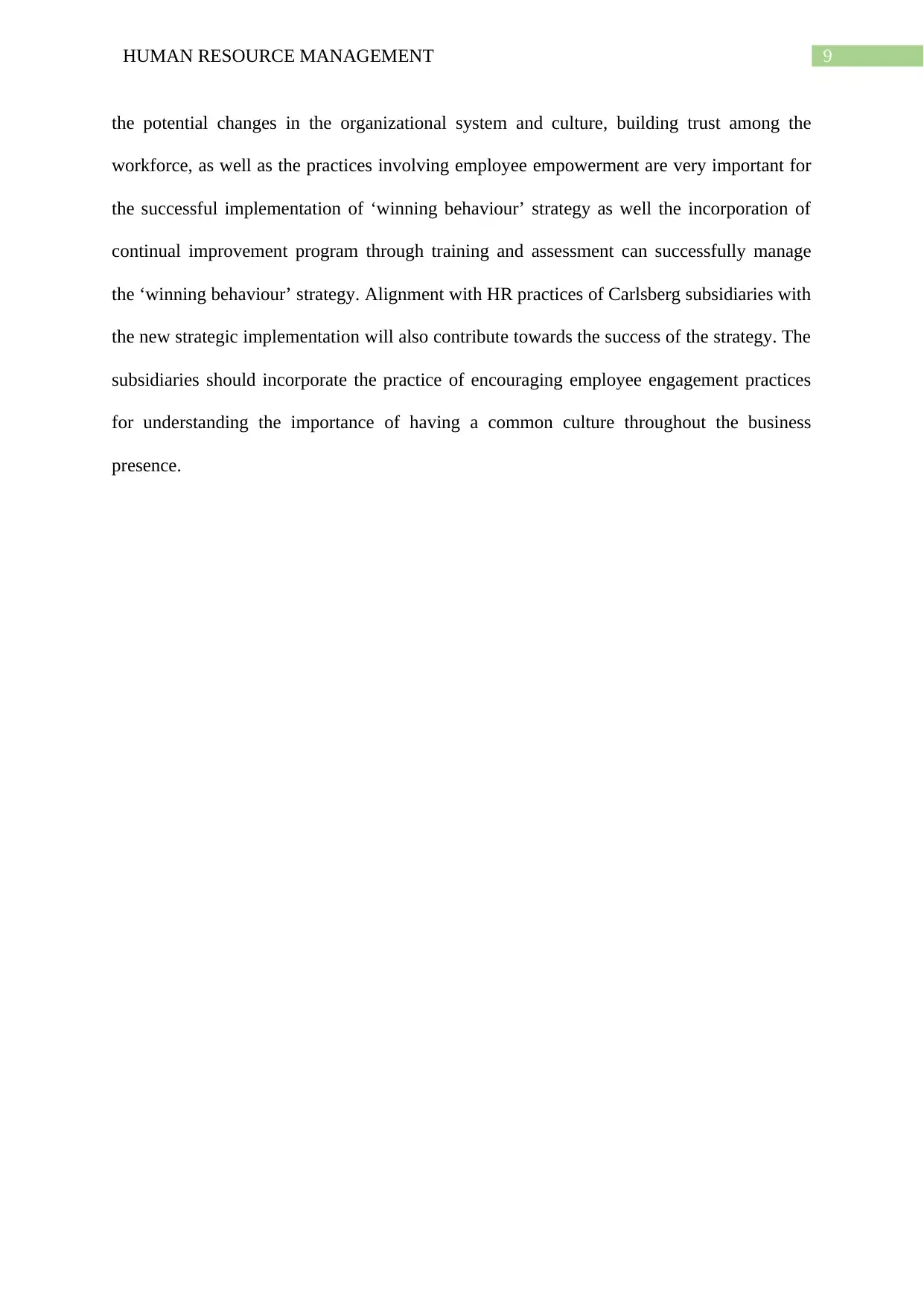
9HUMAN RESOURCE MANAGEMENT
the potential changes in the organizational system and culture, building trust among the
workforce, as well as the practices involving employee empowerment are very important for
the successful implementation of ‘winning behaviour’ strategy as well the incorporation of
continual improvement program through training and assessment can successfully manage
the ‘winning behaviour’ strategy. Alignment with HR practices of Carlsberg subsidiaries with
the new strategic implementation will also contribute towards the success of the strategy. The
subsidiaries should incorporate the practice of encouraging employee engagement practices
for understanding the importance of having a common culture throughout the business
presence.
the potential changes in the organizational system and culture, building trust among the
workforce, as well as the practices involving employee empowerment are very important for
the successful implementation of ‘winning behaviour’ strategy as well the incorporation of
continual improvement program through training and assessment can successfully manage
the ‘winning behaviour’ strategy. Alignment with HR practices of Carlsberg subsidiaries with
the new strategic implementation will also contribute towards the success of the strategy. The
subsidiaries should incorporate the practice of encouraging employee engagement practices
for understanding the importance of having a common culture throughout the business
presence.
Paraphrase This Document
Need a fresh take? Get an instant paraphrase of this document with our AI Paraphraser
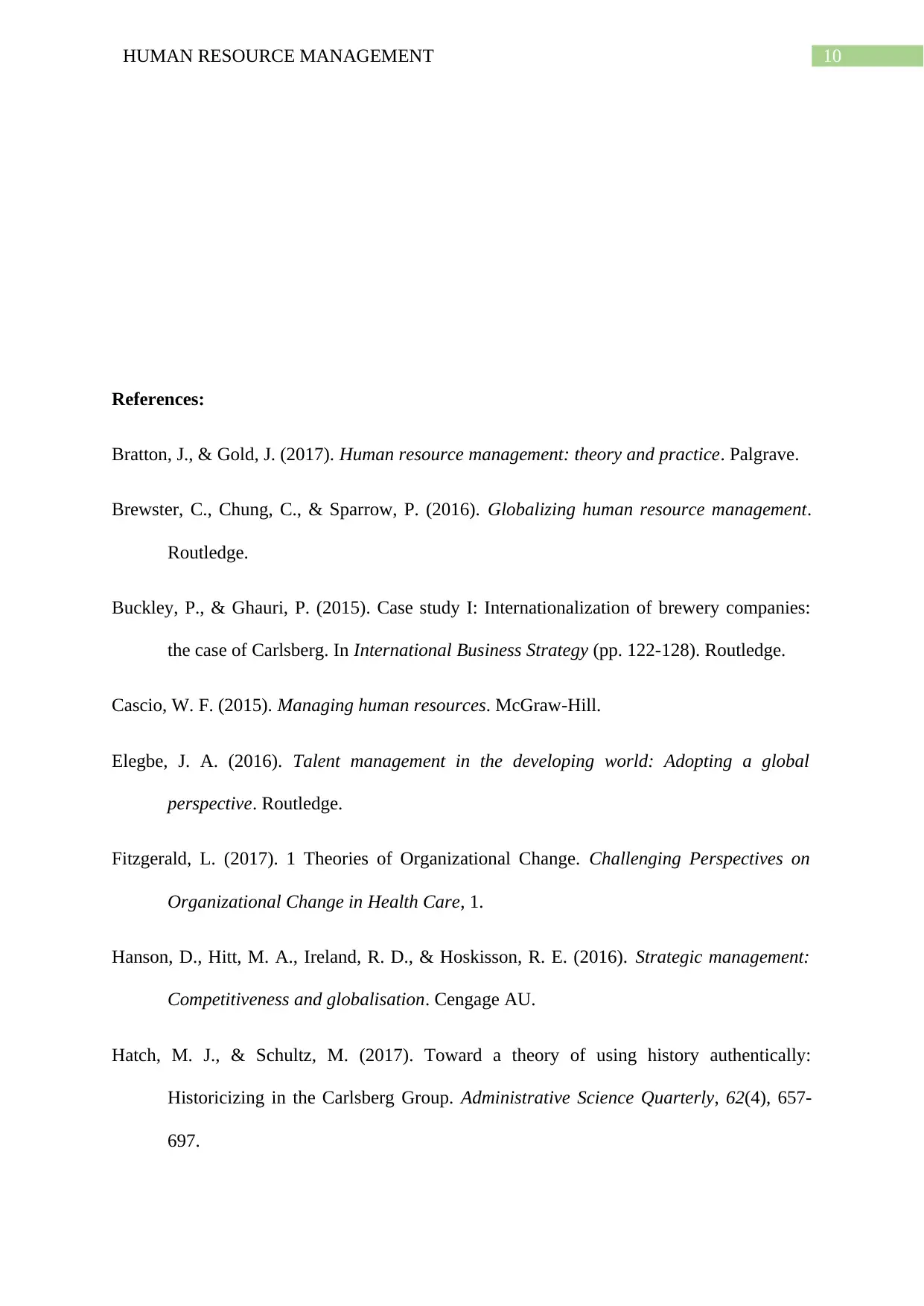
10HUMAN RESOURCE MANAGEMENT
References:
Bratton, J., & Gold, J. (2017). Human resource management: theory and practice. Palgrave.
Brewster, C., Chung, C., & Sparrow, P. (2016). Globalizing human resource management.
Routledge.
Buckley, P., & Ghauri, P. (2015). Case study I: Internationalization of brewery companies:
the case of Carlsberg. In International Business Strategy (pp. 122-128). Routledge.
Cascio, W. F. (2015). Managing human resources. McGraw-Hill.
Elegbe, J. A. (2016). Talent management in the developing world: Adopting a global
perspective. Routledge.
Fitzgerald, L. (2017). 1 Theories of Organizational Change. Challenging Perspectives on
Organizational Change in Health Care, 1.
Hanson, D., Hitt, M. A., Ireland, R. D., & Hoskisson, R. E. (2016). Strategic management:
Competitiveness and globalisation. Cengage AU.
Hatch, M. J., & Schultz, M. (2017). Toward a theory of using history authentically:
Historicizing in the Carlsberg Group. Administrative Science Quarterly, 62(4), 657-
697.
References:
Bratton, J., & Gold, J. (2017). Human resource management: theory and practice. Palgrave.
Brewster, C., Chung, C., & Sparrow, P. (2016). Globalizing human resource management.
Routledge.
Buckley, P., & Ghauri, P. (2015). Case study I: Internationalization of brewery companies:
the case of Carlsberg. In International Business Strategy (pp. 122-128). Routledge.
Cascio, W. F. (2015). Managing human resources. McGraw-Hill.
Elegbe, J. A. (2016). Talent management in the developing world: Adopting a global
perspective. Routledge.
Fitzgerald, L. (2017). 1 Theories of Organizational Change. Challenging Perspectives on
Organizational Change in Health Care, 1.
Hanson, D., Hitt, M. A., Ireland, R. D., & Hoskisson, R. E. (2016). Strategic management:
Competitiveness and globalisation. Cengage AU.
Hatch, M. J., & Schultz, M. (2017). Toward a theory of using history authentically:
Historicizing in the Carlsberg Group. Administrative Science Quarterly, 62(4), 657-
697.
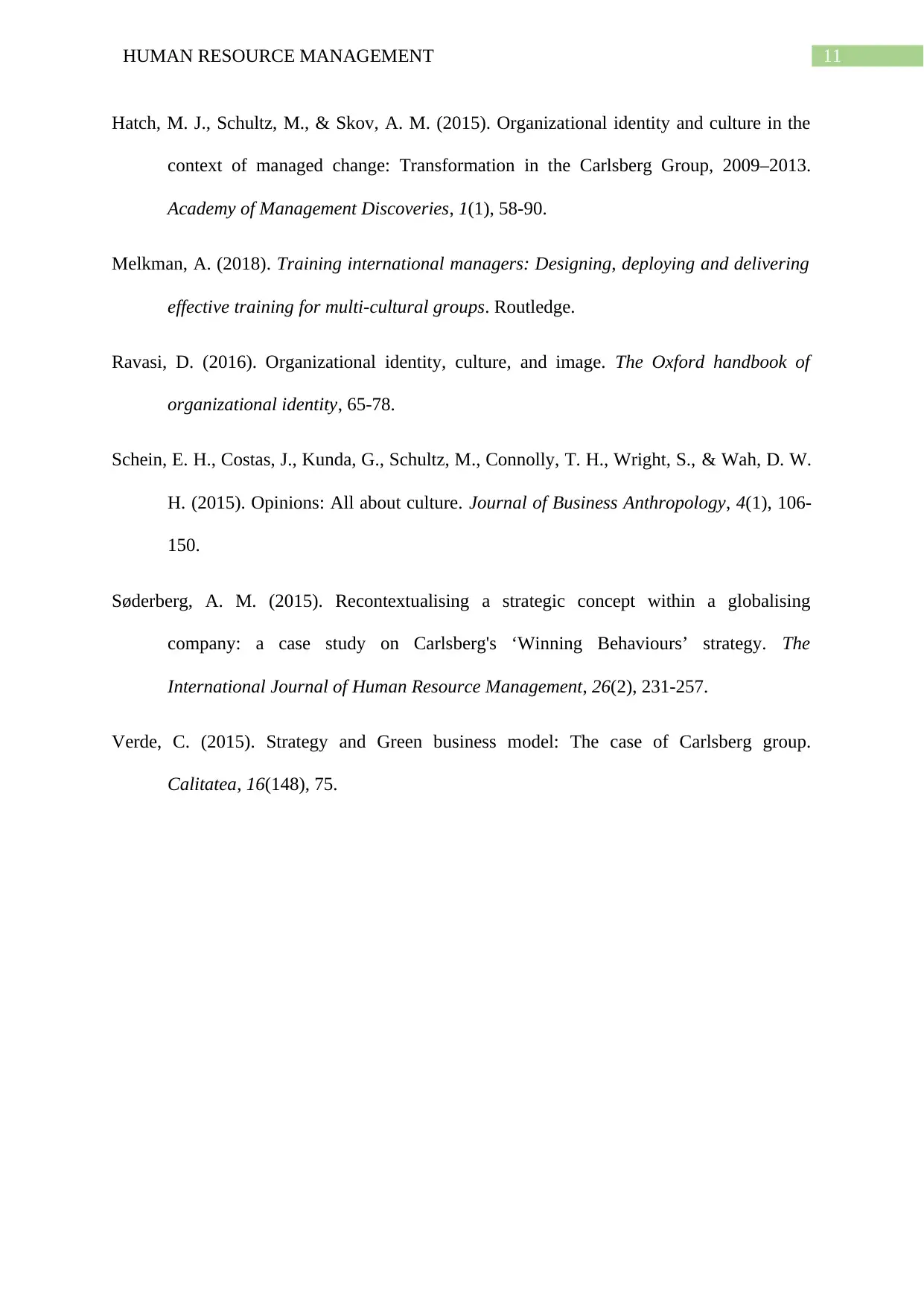
11HUMAN RESOURCE MANAGEMENT
Hatch, M. J., Schultz, M., & Skov, A. M. (2015). Organizational identity and culture in the
context of managed change: Transformation in the Carlsberg Group, 2009–2013.
Academy of Management Discoveries, 1(1), 58-90.
Melkman, A. (2018). Training international managers: Designing, deploying and delivering
effective training for multi-cultural groups. Routledge.
Ravasi, D. (2016). Organizational identity, culture, and image. The Oxford handbook of
organizational identity, 65-78.
Schein, E. H., Costas, J., Kunda, G., Schultz, M., Connolly, T. H., Wright, S., & Wah, D. W.
H. (2015). Opinions: All about culture. Journal of Business Anthropology, 4(1), 106-
150.
Søderberg, A. M. (2015). Recontextualising a strategic concept within a globalising
company: a case study on Carlsberg's ‘Winning Behaviours’ strategy. The
International Journal of Human Resource Management, 26(2), 231-257.
Verde, C. (2015). Strategy and Green business model: The case of Carlsberg group.
Calitatea, 16(148), 75.
Hatch, M. J., Schultz, M., & Skov, A. M. (2015). Organizational identity and culture in the
context of managed change: Transformation in the Carlsberg Group, 2009–2013.
Academy of Management Discoveries, 1(1), 58-90.
Melkman, A. (2018). Training international managers: Designing, deploying and delivering
effective training for multi-cultural groups. Routledge.
Ravasi, D. (2016). Organizational identity, culture, and image. The Oxford handbook of
organizational identity, 65-78.
Schein, E. H., Costas, J., Kunda, G., Schultz, M., Connolly, T. H., Wright, S., & Wah, D. W.
H. (2015). Opinions: All about culture. Journal of Business Anthropology, 4(1), 106-
150.
Søderberg, A. M. (2015). Recontextualising a strategic concept within a globalising
company: a case study on Carlsberg's ‘Winning Behaviours’ strategy. The
International Journal of Human Resource Management, 26(2), 231-257.
Verde, C. (2015). Strategy and Green business model: The case of Carlsberg group.
Calitatea, 16(148), 75.
⊘ This is a preview!⊘
Do you want full access?
Subscribe today to unlock all pages.

Trusted by 1+ million students worldwide
1 out of 12
Related Documents
Your All-in-One AI-Powered Toolkit for Academic Success.
+13062052269
info@desklib.com
Available 24*7 on WhatsApp / Email
![[object Object]](/_next/static/media/star-bottom.7253800d.svg)
Unlock your academic potential
Copyright © 2020–2025 A2Z Services. All Rights Reserved. Developed and managed by ZUCOL.





